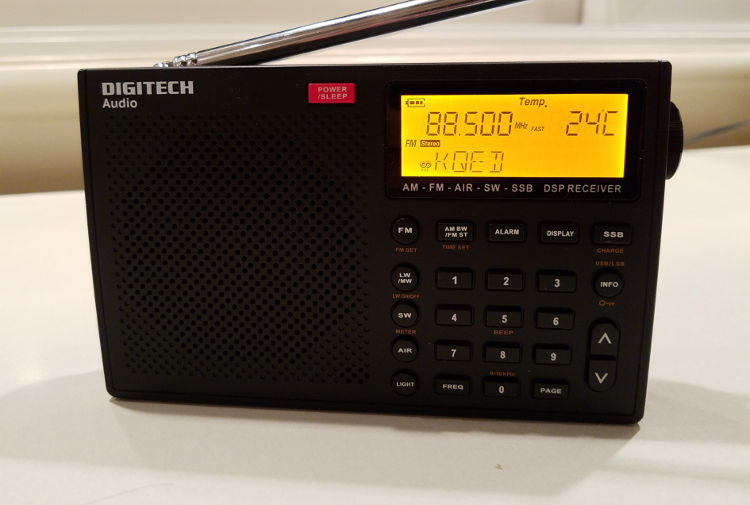
Slightly larger than most DSP-based travel-sized multi-band radios, the Digitech AR-1780 resembles the XHDATA D-808 so closely that I believe the radios are nearly identical in functionality and circuitry. The first noticeable difference is cosmetic: the Digitech is black; the XHDATA is gray.
The Digitech is sold (and was probably commissioned) by the Australian and New Zealander electronics retailer Jaycar. In 2018, Jaycar established a website for American shoppers with products priced in American dollars. At that time, the AR-1780 became somewhat easier to obtain in the United States than the XHDATA D-808. However, by 2023, Jaycar ceased direct sales to the United States, and it's now much more difficult to get outside Australia or New Zealand. When available, the AR-1780 is offered through China-based sellers on eBay.
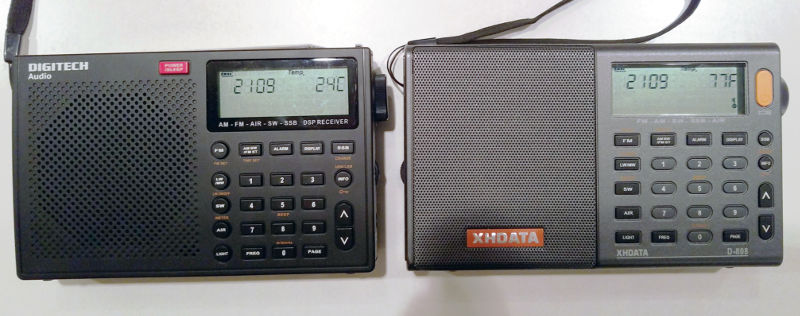
The cabinet sizes of the two radios are very close in size, most easily determined from their metric-system measurements:
- Digitech: 150 mm wide by 95 mm high by 30 mm deep.
- XHDATA: 157 mm wide by 92 mm high by 32 mm deep.
The power switch on the Digitech is toward the top of the radio, but located midway between the left and right sides of the unit. This is an unusual location for a power switch on these types of radios, but it's easy to become accustomed to it. The keys on the front keypad stick out a little more compared to other Chinese-made DSP radios, with some function keys being round rather than rectangular, making them easier to find by touch.
The display appears identical to that of the XHDATA D-808, except that the backlight is yellow rather than the blue-white color of the XHDATA unit.
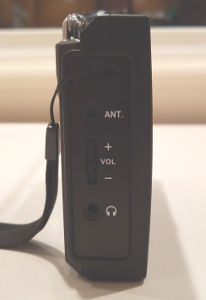
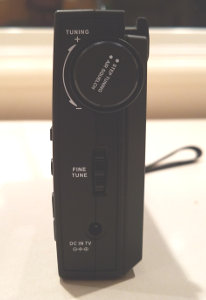
An antenna jack, volume control, and headphone jack are on the left side of the unit. The right side shows one notable difference between the XHDATA D-808 and the AR-1780: instead of a USB jack, there's a power-adapter jack. This reflects another difference between the radios: the AR-1780 uses four standard AA batteries. I strongly prefer the use of standard batteries over lithium-ion batteries, as I have mentioned in other reviews. In theory, one could obtain rechargeable metal-hydride batteries in the standard AA size and charge them through a power supply attached to the power adapter.
But there's a problem with that theory: the power supply is specified as 7 volts. That's an unusual value. I would have expected a 6 or 7.5-volt specification. I don't recommend trying to run any electronic device at a voltage that it doesn't support, so I haven't tried to connect the AR-1780 to a power adapter that uses a more commonly-available value. It's a very odd limitation.
When I first got them, both AR-1780 units seemed to have a slow power drain when turned off, possibly reflecting similar problems I have had with one of my XHDATA units. If used rarely, one set of batteries should have lasted months. Instead, I found that batteries in the AR-1780 lasted around 6 to 8 weeks if the unit is not used often. More frequent use didn't seem to make much of a difference, as long as the radio wasn't on for long stretches of time. It was my belief that the display panel, which is active whether or not the radio is on, may have been the culprit. That said, after having the unit for a year, power consumption seems to have stabilized in both units. The only explanation I have for this is a change of batteries, though I'm using the same brand (Energizer) and type (alkaline) battery as before. All I can reliably say now is that power consumption should be monitored carefully with these radios.
The other difference I've noticed between the XHDATA D-808 and the AR-1780 is that the Digitech radio has slightly better sound from its built-in speaker. The sound is just a little richer and more natural. The XHDATA sounds just fine for news or talk radio, but the AR-1780 is more pleasurable to listen to even when tuned to stations playing music.
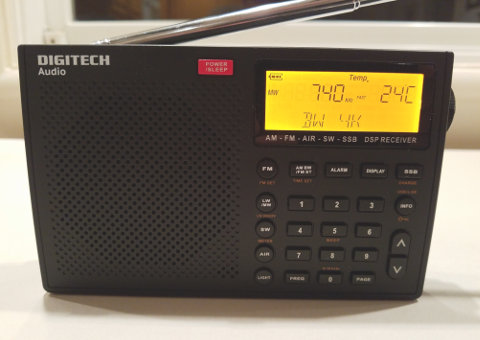
The Digitech radio offers seven audio bandwidths on all bands except FM: 6, 4, 3, 2.5, 2, 1.8, and 1 kHz, selected with the AM BW/FM ST button. The radio also offers single-sideband reception with a different set of bandwidths. There is no "voice/music" filter such as those on the CC Skywave or Radiwow R-108. With the better-quality speaker in the AR-1780, such a filter may not be a major omission, though a tone-control switch would have been nice to include. On FM, stereo reception can be turned on or off with the same switch. Note that stereo listening is only available through headphones.
As with its XHDATA twin, on the AR-1780 one can manually select between temperature readings in Celsius or Fahrenheit - with the radio off, press 3 to toggle between those units of measurement.
A page-based system of memory presets is used, just as with the XHDATA D-808. Automatic memory setting with a station scan is available. Also like the XHDATA D-808, one slightly annoying characteristic of this radio is a nearly two-second pause in audio when switching between bands. This is far more than other DSP-based radios. It was a little surprising at first, though I became quickly accustomed to it. Likewise, when first turning on the radio, there's about a two-second delay before audio starts.
As far as AM and FM reception are concerned, the Digitech AR-1780 performs almost identically to the XHDATA D-808, with only tiny differences between them. For example, on the FM band, the XHDATA seems to do slightly better at the lower end of the band, while the Digitech is a little better at the higher end. It's possible that minor moment-to-moment variations in the reception of weak signals could be at play, too. The antenna is 25 1/2" (65 mm) long - identical to the XHDATA D-808 and still not the correct 30" length for FM reception.
The Digitech AR-1780 also exhibits the same quirks as the XHDATA D-808 regarding stereo FM reception. Its threshold for stereo reception is set to be unusually high. This characteristic could be considered a positive thing by some, because it ensures that FM stereo is relatively free from noise. Weaker FM signals, and even signals of moderate strength, have a higher level of background noise in stereo compared to mono. To put it another way, a higher signal strength is required to get noise-free reception in stereo compared to mono.
Earlier generations of FM radios, such as the Proton 100 and Sony Walkmans, as well as current-day DSP-based radios, set the threshold for stereo at a level that will allows stereo reception even if some background noise results.
If this is a conscious design decision, it's hard to understand, because the Digitech AR-1780 is able to force mono reception for all FM signals. It also makes it a little more difficult to compare the AR-1780's reception performance with other radios. If you don't care about stereo reception, it won't matter to you. But if you use headphones to get stereo reception, it may matter a lot. As with the XHDATA D-808, the Digitech AR-1780 is a very good performer for FM mono reception, but I would give it a lower rating for stereo reception.
In any event, my judgment is that it's an excellent AM performer and FM performer (in mono), though the CC Skywave is slightly better still on AM and Tecsun radios such as the PL-380 are slightly better on FM.
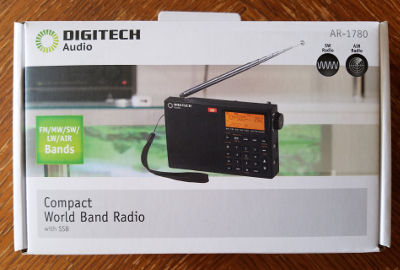
I admit that this is an unusual review, due to the number of comparisons with the nearly identical XHDATA. Much of what I've written about the XHDATA D-808 applies to the Digitech AR-1780 as well. Aside from the bizarre requirement for a 7-volt external power supply (possibly 6 volts would work, but that's at your own risk), the Digitech AR-1780 has more more going for it than the XHDATA D-808:
- It doesn't use lithium-ion batteries.
- The speaker's sound quality is a little richer.
- The ergonomics of the keypad are a slight improvement.
- It's very easy to get in Australia or New Zealand.
As long as you are mindful of battery life, I can recommend the Digitech AR-1780. I ordered two from Jaycar; customer service was good and shipping time typically ran a little more than two weeks from Australia to the west coast of the United States. However, a review on Dave's Radio Receiver Page indicates that availability outside Australia or New Zealand is much more difficult than it was. The review also mentions that the radio is available under the name Deshibo RD1780 from various eBay sellers.